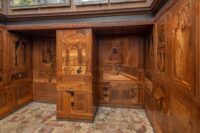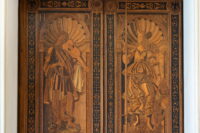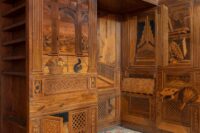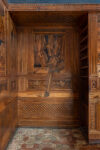 Inside the 15th century Ducal Palace of Urbino is a small room so spectacular that it’s hard to believe your own eyes. It is the studiolo, the tiny private study of Federico III da Montefeltro, Duke of Urbino from 1444 until his death in 1482. He was an exceptionally cultured and literate man, and the palace he had built reflected his interests. His library was the second largest collection of books in Italy after the Vatican’s, and he opened it to all citizens of Urbino making it the first public library in Italy. The walls of the palace are adorned with painting by Old Masters like Raphael, Titian, Piero della Francesco and della Robbia ceramics. The doors of the throne room depicting Apollo and Athena were designed by none other than Sandro Botticelli.
Inside the 15th century Ducal Palace of Urbino is a small room so spectacular that it’s hard to believe your own eyes. It is the studiolo, the tiny private study of Federico III da Montefeltro, Duke of Urbino from 1444 until his death in 1482. He was an exceptionally cultured and literate man, and the palace he had built reflected his interests. His library was the second largest collection of books in Italy after the Vatican’s, and he opened it to all citizens of Urbino making it the first public library in Italy. The walls of the palace are adorned with painting by Old Masters like Raphael, Titian, Piero della Francesco and della Robbia ceramics. The doors of the throne room depicting Apollo and Athena were designed by none other than Sandro Botticelli.
 Like the Botticelli doors, the duke’s studiolo is a masterpiece of a non-painterly medium: marquetry inlay, aka intarsia. Small but beautifully-appointed studies were popular in the palaces of Renaissance aristocrats. They were tiny oases of seclusion where the owners could enjoy private reflection. Federico da Montefeltro’s studiolo was in the heart of the Ducal Palace of Urbino, between rooms he used to receive and for public functions and the palace’s chapel. He used it for private contemplation, mostly, and only his most illustrious guests were invited to cross its threshold.
Like the Botticelli doors, the duke’s studiolo is a masterpiece of a non-painterly medium: marquetry inlay, aka intarsia. Small but beautifully-appointed studies were popular in the palaces of Renaissance aristocrats. They were tiny oases of seclusion where the owners could enjoy private reflection. Federico da Montefeltro’s studiolo was in the heart of the Ducal Palace of Urbino, between rooms he used to receive and for public functions and the palace’s chapel. He used it for private contemplation, mostly, and only his most illustrious guests were invited to cross its threshold.
Now visitors to the Ducal Palace can enter this inner sanctum to be as astonished as his exalted guests must have been. The room is square with a decorative pilaster against one wall that creates two niches on either side of it. Its extreme tininess is masterfully disguised by wood inlay walls in linear perspective attributed to the workshop of brothers Giuliano and Benedetto  da Maiano. The marquetry technique employed here is so vertiginously precise as to create a fully immersive illusion of depth, landscape and architecture on the flat walls of the tiny room. The pilaster, for example, is framed with fluted “columns” bracketing a basket of fruit and a squirrel in the foreground. Behind them a patio reaches back to an arched portico that opens to a hilly landscape. Beneath this scene are fretwork cabinet “doors,” one of them left open.
da Maiano. The marquetry technique employed here is so vertiginously precise as to create a fully immersive illusion of depth, landscape and architecture on the flat walls of the tiny room. The pilaster, for example, is framed with fluted “columns” bracketing a basket of fruit and a squirrel in the foreground. Behind them a patio reaches back to an arched portico that opens to a hilly landscape. Beneath this scene are fretwork cabinet “doors,” one of them left open.
The lower register of the intarsia walls features fretwork panels underneath trompe l’oeil benches, some of which have lifted seats. Above the “seats” is a slim middle register consisting of small rectangular panels on which are represented ducal emblems. The top register is composed of rectangular “cabinets” divided by “columns.” Inside the cabinets are books, candles scientific instruments and musical instruments representing the quadrivium (arithmetic, geometry, music, astronomy) of the seven liberal arts. Between the cabinets are inlay figures representing the three Theological Virtues (Faith, Hope and Charity/Love) and Federico himself with this distinctive notched nose.
(Small digression over the nose. Federico was wounded in a tournament in 1451. The injury took his right eye and damaged the bridge of his nose, severely limiting his field of vision and seemingly at one blow losing him his job as condottiero (military leader for pay) for the Sforza family of Milan. Federico ordered a surgeon to remove the damaged bridge of his nose and the eyelid of his lost eye. It was a drastic approach, but an effective one, restoring his field of vision sufficiently to get him back in the saddle, so to speak, leading men on the battlefield.)
 The left niche has a closet in which the Duke’s armature, symbol of his exceptional skill at arms that earned him the reputation as one of the most successful condottieri in Renaissance Italy, is hanging at rest. This speaks to the purpose of the room. In his studiolo, he could set aside the active life for a brief time and embrace the contemplative life. Indeed, the portrait of him in the top register depicts him draped in Classical robes and holding a lance with the tip pointed downwards. The condettiere lays down his weapons here and becomes the humanist thinker.
The left niche has a closet in which the Duke’s armature, symbol of his exceptional skill at arms that earned him the reputation as one of the most successful condottieri in Renaissance Italy, is hanging at rest. This speaks to the purpose of the room. In his studiolo, he could set aside the active life for a brief time and embrace the contemplative life. Indeed, the portrait of him in the top register depicts him draped in Classical robes and holding a lance with the tip pointed downwards. The condettiere lays down his weapons here and becomes the humanist thinker.
If Urbino is a bit of reach, you can see the very similar marquetry studiolo from Federico da Montefeltro’s palace in Gubbio at the Metropolitan Museum of Art in New York City. The entire room was sold by the Lancellotti family in 1937 to art and antiquities dealer Adolph Loewi. He sold it to the Met in 1939.
This video tour of the studio is too brief for my taste, but it does convey the wonder of the space and the auto-translate CC isn’t half bad.